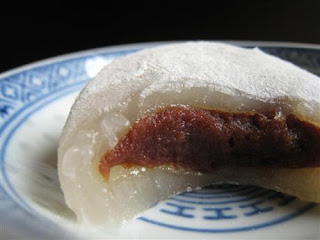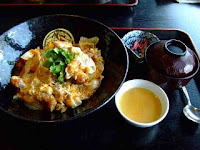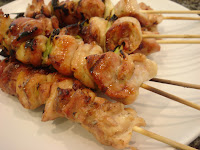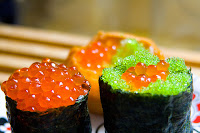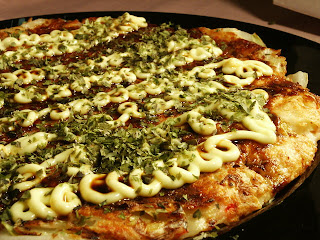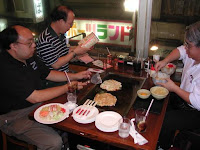Menu Taste and Personal Experience:
 |
| Sushi Boat |
Who did not know sushi these days? This popular Japanese food has been known world wide for its beauty, variety and delicacy. The taste varies and it really depends on its fillings or toppings. I have tried making this menu a couple of times and I really enjoy making it : ). Nowadays, most of the sushi restaurants/bars that I have come across are equipped with sushi trains/sushi boats where prepared sushi are being placed on a plate and they circle around the tracks/waterways. These tracks/waterways usually located past counter seats and/or tables. Billings are done based on the color/shape/pattern of the plate.
Menu Description:
History
The traditional form of sushi is fermented fish and rice, preserved with salt in a process that has been traced to Southeast Asia, where it remains popular today. The term sushi comes from an archaic grammatical form no longer used in other contexts; literally, "sushi" means "it's sour", a reflection of its historic fermented roots.
 |
| Sushi Platter |
The vinegar produced from fermenting rice breaks down the fish proteins into amino acids. This results in one of the five basic tastes, called umami in Japanese. The oldest form of sushi in Japan, narezushi, still very closely resembles this process. In Japan, narezushi evolved into oshizushi and ultimately Edomae nigirizushi, which is what the world today knows as "sushi".
Contemporary Japanese sushi has little resemblance to the traditional lacto-fermented rice dish. Originally, when the fermented fish was taken out of the rice, only the fish was consumed and the fermented rice was discarded. The strong-tasting and smelling funazushi, a kind of narezushi made near Lake Biwa in Japan, resembles the traditional fermented dish. Beginning in the Muromachi period (AD 1336–1573) of Japan, vinegar was added to the mixture for better taste and preservation. The vinegar accentuated the rice's sourness and was known to increase its shelf life, allowing the fermentation process to be shortened and eventually abandoned. In the following centuries, sushi in Osaka evolved into oshi-zushi. The seafood and rice were pressed using wooden (usually bamboo) molds. By the mid 18th century, this form of sushi had reached Edo (contemporary Tokyo).
The contemporary version, internationally known as "sushi", was created by Hanaya Yohei (1799–1858) at the end of the Edo period in Edo. The sushi invented by Hanaya was an early form of fast food that was not fermented (therefore prepared quickly) and could be eaten with one's hands at a roadside or in a theatre. Originally, this sushi was known as Edomae zushi because it used freshly caught fish in the Edo-mae (Edo Bay or Tokyo Bay). Though the fish used in modern sushi no longer usually comes from Tokyo Bay, it is still formally known as Edomae nigirizushi.
Nigirizushi
 |
| Nigiri Sushi |
Nigirizushi (hand-formed sushi) consists of an oblong mound of sushi rice that the chef presses into a small rectangular box between the palms of the hands, usually with a bit of wasabi, and a topping draped over it.
Gunkanmaki (warship roll) is a special type of nigirizushi: an oval, hand-formed clump of sushi rice that has a strip of "nori" wrapped around its perimeter to form a vessel that is filled with some soft, loose or fine-chopped ingredient that requires the confinement of nori such as roe, natto, oysters, sea urchin, corn with mayonnaise, and quail eggs.Gunkan-maki was invented at the Ginza Kyubey restaurant in 1931; its invention significantly expanded the repertoire of soft toppings used in sushi.
Temarizushi (ball sushi) is a ball-shaped sushi made by pressing rice and fish into a ball-shaped form by hand using a plastic wrap. They are quite easy to make and thus a good starting point for beginners.
Makizushi
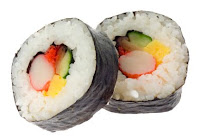 |
| Maki Sushi |
Makizushi (rolled sushi), Norimaki (Nori roll) or makimono (variety of rolls) is a cylindrical piece, formed with the help of a bamboo mat, called a makisu. Makizushi is generally wrapped in nori, but can occasionally be found wrapped in a thin omelette, soy paper, cucumber, or parsley.
Futomaki (thick, large or fat rolls) is a large cylindrical piece, with nori on the outside. A typical futomaki is three or four centimeters (1.5 in) in diameter. They are often made with two or three fillings that are chosen for their complementary tastes and colors.
 |
| Hosomaki |
Hosomaki (thin rolls) is a small cylindrical piece, with the nori on the outside. A typical hosomaki has a diameter of about two centimeters (0.75 in). They generally contain only one filling, often tuna, cucumber, kanpyō, thinly sliced carrots, or, more recently, avocado.
 |
| Temaki |
Temaki (hand rolls) is a large cone-shaped piece of nori on the outside and the ingredients spilling out the wide end. A typical temaki is about ten centimeters (4 in) long, and is eaten with fingers because it is too awkward to pick it up with chopsticks. For optimal taste and texture, Temaki must be eaten quickly after being made because the nori cone soon absorbs moisture from the filling and loses its crispness and becomes somewhat difficult to bite.
Uramaki (inside-out rolls) is a medium-sized cylindrical piece, with two or more fillings. Uramaki differs from other makimono because the rice is on the outside and the nori inside. The filling is in the center surrounded by nori, then a layer of rice, and an outer coating of some other ingredients such as roe or toasted sesame seeds.
Oshizushi
Oshizushi (pressed sushi), is a pressed sushi from the Kansai Region, a favourite and specialty of Osaka. A block-shaped piece formed using a wooden mold, called an oshibako. The chef lines the bottom of the oshibako with the toppings, covers them with sushi rice, and then presses the lid of the mold down to create a compact, rectilinear block. The block is removed from the mold and then cut into bite-sized pieces.
Inarizushi
Inarizushi
 |
| Inari Sushi |
Inarizushi is a pouch of fried tofu filled with usually just sushi rice. It is named after the Shinto god Inari, who is believed to have a fondness for fried tofu. The pouch is normally fashioned as deep-fried tofu (abura age).
Chirashizushi
 |
| Chirasi Sushi |
Chirashizushi (scattered sushi) is a bowl of sushi rice topped with a variety of sashimi and garnishes (also refers to barazushi). Edomae chirashizushi (Edo-style scattered sushi) is an uncooked ingredient that is arranged artfully on top of the sushi rice in a bowl. Gomokuzushi (Kansai-style sushi) are cooked or uncooked ingredients mixed in the body of rice in a bowl. It is eaten annually on Hinamatsuri in March.
Narezushi
 |
| Nare Sushi |
Narezushi (matured sushi) is a traditional form of fermented sushi. Skinned and gutted fish are stuffed with salt, placed in a wooden barrel, doused with salt again, then weighed down with a heavy tsukemonoishi (pickling stone). As days pass, water seeps out and is removed. After six months this funazushi can be eaten, remaining edible for another six months or more.
Western-style sushi
 |
| Western Style Sushi |
The increasing popularity of sushi around the world has resulted in variations typically found in North America and Europe, but rarely in Japan. Such creations to suit the Western palate were initially fueled by the invention of the California roll. A wide variety of popular rolls has evolved since.
Condiments
Sushi is commonly eaten with condiments. Sushi may be dipped in shōyu, soy sauce, and may be flavored with wasabi, a piquant paste made from the grated root of the Wasabia japonica plant. However, some consider the use of condiments with sushi to be rude, as it implies that the chef's original preparation was inadequate.
 |
| Gari - Japanese Pickled Ginger |
True wasabi has anti-microbial properties and may reduce the risk of food poisoning. The traditional grating tool for wasabi is a sharkskin grater or samegawa oroshi. An imitation wasabi (seiyo-wasabi), made from horseradish, mustard powder and green dye is common. It is found at lower-end kaiten zushi restaurants, in bento box sushi and at most restaurants outside of Japan. If manufactured in Japan, it may be labelled "Japanese Horseradish".
Gari, sweet, pickled ginger is eaten with sushi to both cleanse the palate and aid in digestion. In Japan, green tea (ocha) is invariably served together with sushi. Better sushi restaurants often use a distinctive premium tea known as mecha. In sushi vocabulary, green tea is known as agari.
Sushi Rice Recipe
Menu Ingredients:
3 cups uncooked sushi or sticky or plain rice
3 cups water
½ cup rice/white/brown vinegar
½ cup sugar
1 teaspoon salt
Menu Directions:
1. Wash the rice and rinse thoroughly.
 |
| Sushi |
2. Place rice and water in a rice cooker and set until cooked. Alternately, place rice and water in a medium saucepan. Bring to a boil over high heat, reduce to a simmer, and cook covered until done, 35 to 45 minutes.
3. Meanwhile, mix together the rice vinegar, sugar and salt in a small saucepan; cook over medium heat until sugar has dissolved. Allow to cool.
4. Put the cooked rice into a large mixing bowl; pour the vinegar sauce over the hot rice and mix. Allow to cool slightly before using in sushi recipes.
For other sushi recipes, please have a look at the sushi section of Japanese Menu.
Menu Related Videos:
How to make Japanese Menu Temaki Sushi
Sushi restaurant at Tokyo
Tokyo sushi train
Sushi Boat
Menu Sources and References:
 I was surfing the internet, looking at various stuff until my eyes caught on something that greatly interest me. It was yakisoba pan!! I thought that it is a really unique kind of food. It’s kinda disappointing that I did not find any stall that sell yakisoba pan while I am holidaying at Japan couple years ago. I went to one of the New Year’s Eve festival but all I could find was yakisoba vendor. So I decided to research about it a bit. I tried cooking it myself several weeks ago. The hardest part was finding the required ingredients, especially the packaged chuka noodle, couldn’t find it anywhere except one store. Anyway making yakisoba pan is really fun, just scroll down to find the ingredients and directions on how to make it.
I was surfing the internet, looking at various stuff until my eyes caught on something that greatly interest me. It was yakisoba pan!! I thought that it is a really unique kind of food. It’s kinda disappointing that I did not find any stall that sell yakisoba pan while I am holidaying at Japan couple years ago. I went to one of the New Year’s Eve festival but all I could find was yakisoba vendor. So I decided to research about it a bit. I tried cooking it myself several weeks ago. The hardest part was finding the required ingredients, especially the packaged chuka noodle, couldn’t find it anywhere except one store. Anyway making yakisoba pan is really fun, just scroll down to find the ingredients and directions on how to make it.  Yakisoba is most familiarly served on a plate either as a main dish or a side dish. Another popular way to prepare and serve yakisoba in Japan is to pile the noodles into a bun sliced down the middle in the style of a hot dog, and garnish the top with mayonnaise and shreds of pickled ginger. Called yakisoba-pan, pan meaning bread, it is commonly available at local matsuri (Japanese festivals) or konbini (convenience stores).
Yakisoba is most familiarly served on a plate either as a main dish or a side dish. Another popular way to prepare and serve yakisoba in Japan is to pile the noodles into a bun sliced down the middle in the style of a hot dog, and garnish the top with mayonnaise and shreds of pickled ginger. Called yakisoba-pan, pan meaning bread, it is commonly available at local matsuri (Japanese festivals) or konbini (convenience stores). Sometimes, Japanese white Udon is used as a replacement of Chinese style Soba and called Yakiudon. This variation was started in Kitakyushu in Fukuoka Prefecture.
Sometimes, Japanese white Udon is used as a replacement of Chinese style Soba and called Yakiudon. This variation was started in Kitakyushu in Fukuoka Prefecture.








